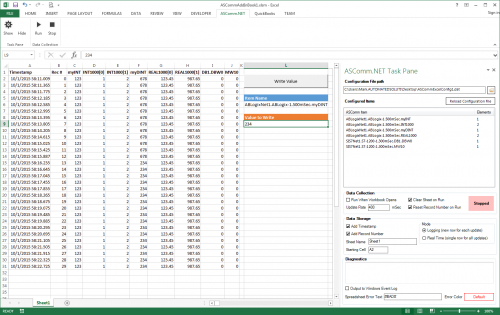Search the Community
Showing results for tags 'clock toolchest rx3i quickpanel'.
Found 33 results
-
Version 3.11.2.0
84 downloads
ASComm Excel Add-in is a simple to use, non-programmatic way to populate Excel 2007 - 2021 spreadsheets with data from PLCs, instrumentation, and other process hardware. ASComm Excel Add-in uses built-in drivers for GE / Emerson PACSystems (RXi, RX3i, RX7i), Series 90 (90-30), and VersaMax communications. No OPC, DDE, external drivers, or programming required. -
Dear, I need some help with an application in ml1500 with the RTC . I need an exit is enabled by days of the week . I´m programming in Rslogix500. Program follows the image. If possible help me. Thanks Daniel.
-
Hi All, I am trying to setup the communication between GEIP PACSystems Rx3i and Schneider Electric CitecSCADA 7.1 Does anyone have the procedure? Thanks Chris
-
Version 1.0.0
49 downloads
Updated Clock logic and HMI screen simple and well documented. To use this, 'Import' this 'Toolchest' Drawer file into your PMC's Toolchest. Then 'Copy' one of the Ladder Blocks into your 90-30 or PAC Rx3i Target by holding down the Ctrl key while drag-n-dropping it onto the 'Program Blocks' in the Navigator window. The QuickPanel Screen along with the 'Indexed Message Grid' can similarly be brought into your QP or QP+ Target. If there is already variables in your project you may need to adjust some or all of those used here. The logic here also will help you to understand the Array_Move Function blocks in PME. -
Clock_S90_PAC_QP+.zdrw View File Updated Clock logic and HMI screen simple and well documented. To use this, 'Import' this 'Toolchest' Drawer file into your PMC's Toolchest. Then 'Copy' one of the Ladder Blocks into your 90-30 or PAC Rx3i Target by holding down the Ctrl key while drag-n-dropping it onto the 'Program Blocks' in the Navigator window. The QuickPanel Screen along with the 'Indexed Message Grid' can similarly be brought into your QP or QP+ Target. If there is already variables in your project you may need to adjust some or all of those used here. The logic here also will help you to understand the Array_Move Function blocks in PME. Submitter RussB Submitted 01/05/16 Category PLC Sample Code
-

Updating PanelView C600 Clock from Micro850
bainsteven posted a topic in Allen Bradley / Rockwell Automation
Hiya Guys, New here (first post!) - and I'm fairly new to Connected Components Workbench, so apologies for the mammoth post! I am currently developing a System using one Micro850 PLC and one PanelView C600 HMI. I am able to update the current HMI time by sending Unsigned-Integers to Global Connection Tags: System Clock – Hour ($SysClockHour);System Clock – Minute ($SysClockMinute);System Clock – Second ($SysClockSecond);However, if using the same “update time” more than once, this method does not work as the HMI is looking for a “change” in a Tag before an update occurs (Tag-specific). For example, we require to be able to receive a “synchronisation signal” on a digital-input on the PLC each day at 15:00:00. This will only work once as, even though the HMI’s current time updates every second, I will still be sending the values “15”, “0”, and “0” to the above Tags (which will therefore not force an update – as they haven’t changed). I cannot reset these Tags without updating the current Time – as any number “out of range” causes an error (incidentally the errors are shown on the HMI to occur on Tags “SysClockSecondTimed”, “SysClockMinuteTimed”, and “SysClockHour” – note the omission of the word “Timed” on the Hours error…). There appears to be no reference to these “Timed” Tags anywhere in CCW, and I have no idea why the “Hour” update errors on a different (the correct?!) Tag. It’s a pretty confusing problem and difficult to explain… it took me a while to get my head around it – and I can see what the code is doing! J I've looked for documentation on how these Global Connection Tags work, but I can't find anything. Everything I (think I) know so far is from extensive testing... so if anyone knows of any documentation, or has any suggestions as to how I can achieve the required result - that would be massively helpful! Thanks for taking the time to read all this! Cheers, Steve. -
Hey guys, sorry for all of the newbie questions, I had 1-2 years of PLC training at a tech school, and then I got a job where I didn't use my knowledge at all for 2 years, and now my current job is all PLCs, and I have forgotten some of the stuff I learned, but it's coming back to me, so I appreciate all the help with the stupid questions. Anyways, here is my question. I am using a MicroLogix 1100 running RSLogix 500 to collect data on a few of our machines about scrap parts and run time vs down time. I just have some basic inputs hooked up to it. I need to be able to send the data to an integer file at the end of every shift, and then reset the current data (easy enough for me, at a certain time I will use a MOV function to move the info from the timers and counters to integers and then use a RES function to reset everything that I want). Anyways, my question is how to I tap into the free running clock built into the MicroLogix 1100? I see that it is S2:4, but I am confused how to use it or set it. I just set one up on a SLC 5/05 and that was super easy, I just set the time while it was online, and then used 3 different COMPARE functions to tell it when I wanted to move/reset the data (I used S:40, S:41 and S:42). Anyways, I can't seem to figure out how to tap into this clock on the MicroLogix 1100. Can anyone help me with a "dumbed down" step-by-step guide. I just want data sent at 6:30, 14:30 and 22:30 and then data reset 2 seconds after each of those times. Any help is truly and honestly appreciated and very useful. Thank you in advanced. Howard
- 3 replies
-
- Micrologix
- 1100
-
(and 1 more)
Tagged with:
-

GE SRTP Ethernet Driver for .NET Framework (2.0 - 4.8)
Automated Solutions posted a file in Demo Software
Version 3.11.5.0
1511 downloads
.NET class library for use in Visual Studio.NET to create HMI/SCADA apps that communicate with GE SRTP PLCs and compatible devices via Ethernet. Supports GE/Emerson PACSystems, Series 90, and VersaMax. For .NET Framework 2.0 - 4.8 projects. Supports PACSystems symbolic variables and CPU rack + slot specification Does not require 3rd party drivers Does not require OPC x86, x64, and Any CPU compatible Visual Studio.NET 2010, 2012, 2013, 2015, 2017, 2019, and 2022 compatible Most .NET targets are supported, including Web, Win Forms, WPF, console, and service apps Build Windows Forms, console, and ASP.NET applications that run on Linux with Mono framework Extremely high performance - 5~10 mSec typical transaction time Optimizes multiple register configurations into minimal transactions Tag database can be configured via code or visual designer Abstract base classes allow you to write generic code that works with all drivers Synchronous and asynchronous read/write methods Data change notifications Provides common user interface across all driver classes No limit on number of devices or data points Multi-threaded for high data throughput Includes extensive help system Windows, Console, and Web Example applications with VB and C# source code included. Easily connect office systems to factory floor. Free 30 day fully functioning trial version available for download Runtime-free for qualified applications



